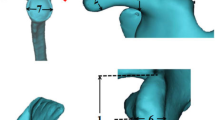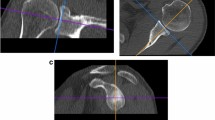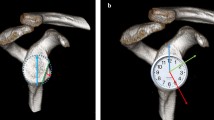Abstract
Introduction
Congruent arc Latarjet procedure involves rotating the coracoid process so that its inferior surface is flush with the glenoid face, owing to their matching radius of curvature (ROC). However, there has been no cadaveric study to actually measure and compare the ROC of coracoid with glenoid, especially in Indian population.
Materials and methods
44 shoulders were dissected in 24 cadavers to measure usable length of coracoid process, width, height, ROC of coracoid and glenoid as well as ulnar length (as proxy of cadaver height). Critical coracoid height and length were estimated based on screw sizes of 2.7 mm, 3.5 mm, 4 mm and 4.5 mm, and pair concordance between height and length calculated. ROC of coracoid and glenoid were compared to measure extent of congruency.
Results
The mean usable length of coracoid process, width and height at mid-point were 21.8 mm, 13.7 mm and 8.6 mm, respectively. Out of the different screw sizes, 2.7 mm screws were found safe in 82% shoulders. 24 coracoid–glenoid pairs fulfilled the operational definition (≤ 5 mm) of congruency while rest 20 were seemingly incongruent chiefly due to coracoid variations, with mean ROC difference 4.13 mm (95% CI 1.51–6.74 mm). The ulnar length was significantly smaller in the incongruent ROC group (p = 0.0002).
Conclusions
The available length as well as height of the transferred coracoid must be considered when deciding optimum diameter fixation screws in Latarjet procedure. Owing to smaller anatomic dimensions of coracoid in Indian population, 2.7-mm screws provide the safest fixation option. Also, the ROC of coracoid and glenoid does not match in substantial proportion of the cadavers. Pre-operative planning should include a CT-based assessment of glenoid and coracoid dimensions to decide the technique of Latarjet procedure and the optimum diameter fixation screws required.









Similar content being viewed by others
References
Allain J, Goutallier D, Glorion C (1998) Long-term results of the Latarjet procedure for the treatment of anterior instability of the shoulder. J Bone Joint Surg Am 80:841–852. https://doi.org/10.2106/00004623-199806000-00008
Burkhart SS, De Beer JF, Barth JRH et al (2007) Results of modified Latarjet reconstruction in patients with anteroinferior instability and significant bone loss. Arthrosc J Arthrosc Relat Surg Off Publ Arthrosc Assoc N Am Int Arthrosc Assoc 23:1033–1041. https://doi.org/10.1016/j.arthro.2007.08.009
Latarjet M (1954) Treatment of recurrent dislocation of the shoulder. Lyon Chir 49:994–997
de Beer JF, Roberts C (2010) Glenoid bone defects–open Latarjet with congruent arc modification. Orthop Clin N Am 41:407–415. https://doi.org/10.1016/j.ocl.2010.02.008
Terra BB, Ejnisman B, de Figueiredo EA et al (2013) Anatomic study of the coracoid process: safety margin and practical implications. Arthrosc J Arthrosc Relat Surg Off Publ Arthrosc Assoc N Am Int Arthrosc Assoc 29:25–30. https://doi.org/10.1016/j.arthro.2012.06.022
Dolan CM, Hariri S, Hart ND, McAdams TR (2011) An anatomic study of the coracoid process as it relates to bone transfer procedures. J Shoulder Elbow Surg 20:497–501. https://doi.org/10.1016/j.jse.2010.08.015
Alvi HM, Monroe EJ, Muriuki M et al (2016) Latarjet fixation. Orthop J Sports Med. https://doi.org/10.1177/2325967116643533
Fathi M, Cheah P-S, Ahmad U et al (2017) Anatomic variation in morphometry of human coracoid process among Asian population. Bio Med Res Int. https://doi.org/10.1155/2017/6307019
Lian J, Dong L, Zhao Y et al (2016) Anatomical study of the coracoid process in Mongolian male cadavers using the Latarjet procedure. J Orthop Surg. https://doi.org/10.1186/s13018-016-0461-3
Knapik DM, Cumsky J, Tanenbaum JE et al (2018) Differences in coracoid and glenoid dimensions based on sex, race, and age: implications for use of the Latarjet technique in glenoid reconstruction. HSS J® 14:238–244. https://doi.org/10.1007/s11420-018-9618-4
Sahu D, Jagiasi J (2019) Intraoperative and anatomic dimensions of the coracoid graft as they pertain to the Latarjet-Walch procedure. J Shoulder Elbow Surg 28:692–697. https://doi.org/10.1016/j.jse.2018.09.013
Dumont GD, Vopat BG, Parada S et al (2017) Traditional versus congruent arc Latarjet technique: effect on surface area for union and bone width surrounding screws. Arthrosc J Arthrosc Relat Surg 33:946–952. https://doi.org/10.1016/j.arthro.2016.09.035
Giles JW, Puskas G, Welsh M et al (2012) Do the traditional and modified Latarjet techniques produce equivalent reconstruction stability and strength? Am J Sports Med 40:2801–2807. https://doi.org/10.1177/0363546512460835
Ghodadra N, Gupta A, Romeo AA et al (2010) Normalization of glenohumeral articular contact pressures after Latarjet or iliac crest bone-grafting. J Bone Joint Surg Am 92:1478–1489. https://doi.org/10.2106/JBJS.I.00220
Gooding BWT, Cresswell TR, Sloan R et al (2011) Glenoid and coracoid morphology are ideally matched for the congruent-arc Latarjet. Shoulder Elb 3:17–21. https://doi.org/10.1111/j.1758-5740.2010.00094.x
Gregori M, Eichelberger L, Gahleitner C, Hajdu S, Pretterklieber M (2020) Relationship between the thickness of the coracoid process and Latarjet graft positioning-an anatomical study on 70 embalmed scapulae. J Clin Med 9:E207. https://doi.org/10.3390/jcm9010207
Radius of an Arc or Arch—Math Open Reference. https://www.mathopenref.com/arcradius.html. Accessed 12 Aug 2019
Pandey A, Radhika PM, Shetty S (2017) Estimation of human stature from length of ulna in Indian population. Int J Anat Res 5:3350–3353. https://doi.org/10.16965/ijar.2016.473
Kumar Mondal M (2012) Height prediction from ulnar length in females: a study in Burdwan District of West Bengal (regression analysis). J Clin Diagn Res. https://doi.org/10.7860/JCDR/2012/4589.2369
Reduction & Fixation - Lag screw and neutralization plate - A2 - AO Surgery Reference. https://www2.aofoundation.org/wps/portal/!ut/p/a0/04_Sj9CPykssy0xPLMnMz0vMAfGjzOKN_A0M3D2DDbz9_UMMDRyDXQ3dw9wMDAzMjfULsh0VAbWjLW0!/?bone=DogFemur&classification=d32-A2&implantstype=&method=Lag%2520screw%2520and%2520neutralization%2520plate&redfix_url=&segment=Shaft&showPage=redfix&treatment=Operative. Accessed 1 Sep 2019
Shibata T, Izaki T, Miyake S et al (2019) Predictors of safety margin for coracoid transfer: a cadaveric morphometric analysis. J Orthop Surg. https://doi.org/10.1186/s13018-019-1212-z
Willemot LB, Wodicka R, Bosworth A et al (2018) Influence of screw type and length on fixation of anterior glenoid bone grafts. Shoulder Elb 10:32–39. https://doi.org/10.1177/1758573217704817
Armitage MS, Elkinson I, Giles JW, Athwal GS (2011) An anatomic, computed tomographic assessment of the coracoid process with special reference to the congruent-arc Latarjet procedure. Arthrosc J Arthrosc Relat Surg Off Publ Arthrosc Assoc N Am Int Arthrosc Assoc 27:1485–1489. https://doi.org/10.1016/j.arthro.2011.06.020
Funding
No financial support was provided for this study. This study was carried out at AIIMS Bhopal, India.
Author information
Authors and Affiliations
Corresponding author
Ethics declarations
Conflict of interest
Manoj Nagar, Vivek Tiwari, Ankur Joshi, Mohtashim Ahmed and Manmohan Patel declare that they have no conflict of interest.
Ethical approval
All procedures performed in studies involving human participants were in accordance with the ethical standards of the institutional and/or national research committee (include name of committee + reference number) and with the 1964 Helsinki Declaration and its later amendments or comparable ethical standards.
Name of the IRB providing approval
Institutional Human Ethics Committee, AIIMS Bhopal Study Number: IM0174.
Additional information
Publisher's Note
Springer Nature remains neutral with regard to jurisdictional claims in published maps and institutional affiliations.
Rights and permissions
About this article
Cite this article
Nagar, M., Tiwari, V., Joshi, A. et al. A cadaveric morphometric analysis of coracoid process with reference to the Latarjet procedure using the “congruent arc technique”. Arch Orthop Trauma Surg 140, 1993–2001 (2020). https://doi.org/10.1007/s00402-020-03579-0
Received:
Accepted:
Published:
Issue Date:
DOI: https://doi.org/10.1007/s00402-020-03579-0




